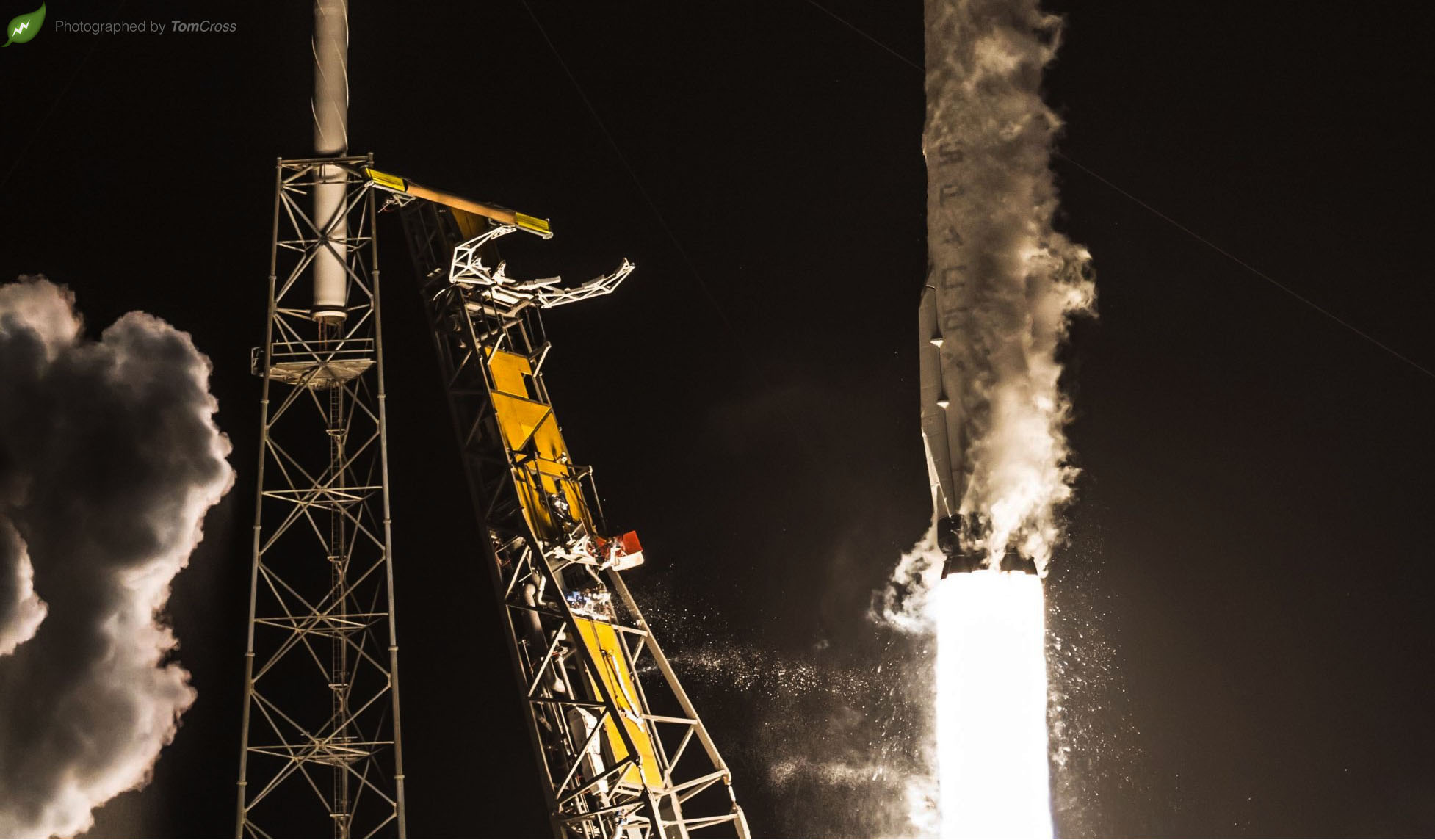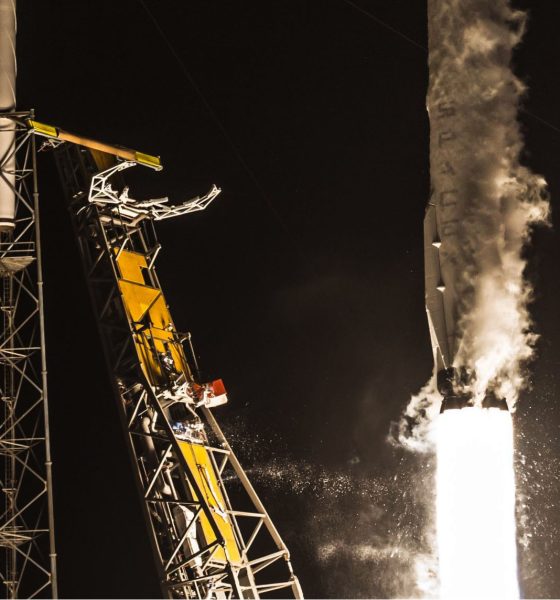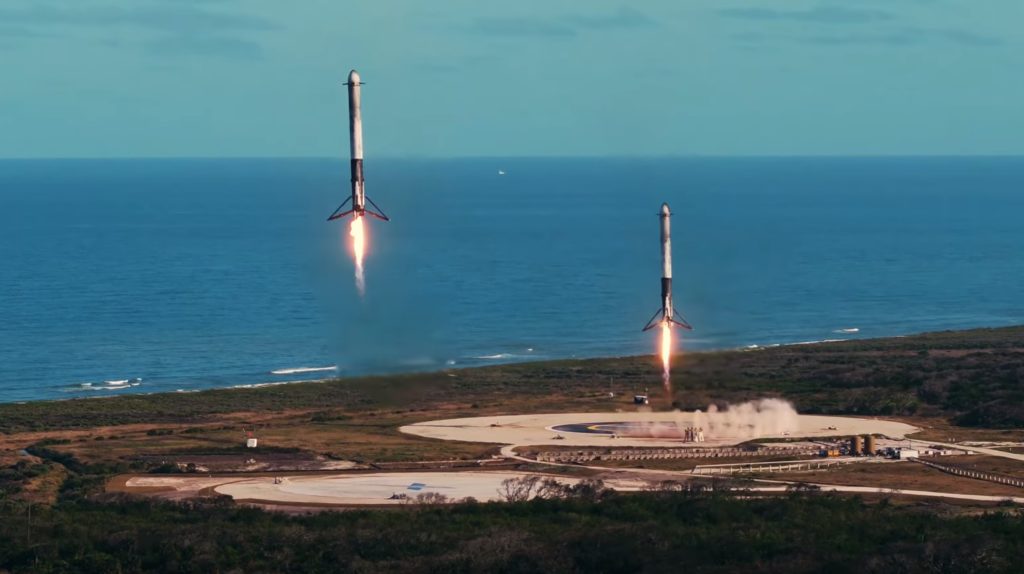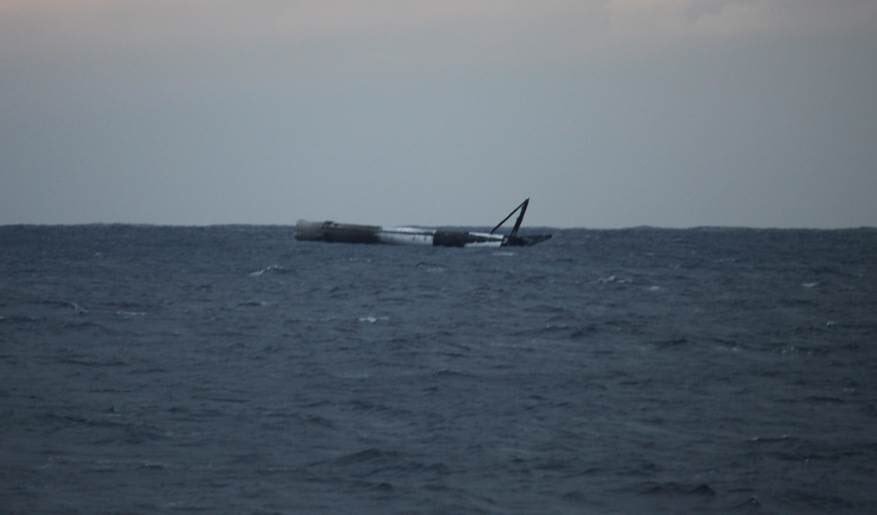

News
SpaceX Falcon 9 Block 5 will usher in a new era of rapid reuse rockets
Despite all missions being readily in the range of recovery, SpaceX has only attempted to recover its Falcon boosters after two of the company’s five 2018 launches. If anything, the attachment to Falcon boosters and the apparent melancholy felt by many observers when they are not recovered is a testament to the staggeringly abrupt success of SpaceX’s reusable rocketry program.
- Falcon Heavy’s side boosters seconds away from near-simultaneous landings at Landing Zones 1 and 2. (SpaceX)
- GovSat’s Falcon 9 1032 spotted in one piece by Elon Musk after a soft-landing in the Atlantic. (Elon Musk)
Aside from Falcon Heavy’s center core and 1044, each booster expended in the last several months (Iridium-4, GovSat-1, and PAZ) was aging, flight-proven, and nearing the end of its operational life: Block 3 and Block 4 Falcon 9s were simply not designed or expected to fly more than two or three times total. Their seemingly premature deaths were thus a necessary step along the path to Block 5 and truly rapid and cheap booster reuse; perhaps as pragmatic as quite literally making space for new and superior hardware at SpaceX’s many facilities. The demise of Falcon Heavy’s center core nevertheless made for a spectacular video (skip to 1:10, or watch the whole thing…).
The end (of old Falcons) is nigh
Despite the carnage in recent times, the next two weeks are likely to see several more flight-proven Falcon 9s meet their timely, watery demise, or at least complete their final flight in the case of CRS-14.
- Iridium-5 (NET March 29) will be flying atop Booster (B) 1041, previously used for Iridium-3 (Oct. 2017)
- CRS-14 (NET April 2) will make use of B1039, a booster that debuted with the launch of CRS-12 (Aug. 2017)
- Iridium-6/GRACE-FO (NET April 28) was confirmed just yesterday to be flying on B1043, the booster that launched the now-infamous Zuma spysat this January
- Lastly, SES-12 (NET April 30) will likely use B1040, which orbited the USAF’s secretive X-37B spaceplane in Sept. 2017
- Booster 1041 arrives in Port of San Pedro, CA in Oct. 2017 after successfully completing its first launch. (Pauline Acalin)
- Booster 1039 lands after successfully launching CRS-12’s Cargo Dragon into orbit. 1039 completed its final mission on Monday afternoon, April 2. (SpaceX)
- After landing at LZ-1, B1043 was refurbished in approximately four months. (SpaceX)
- Falcon 9 B1040 returns to LZ-1 after the launch of the USAF’s X-37B spaceplane. (SpaceX)
While more than a little hard to believe, this series of launches over the next 4-6 weeks may see SpaceX’s fleet of flight-proven boosters shrink to no more than two flightworthy cores – perhaps just a single Falcon 9. The launch of NASA’s exoplanet observatory TESS – set to use the brand new Falcon 9 B1045 – will likely see one additional flight after landing at LZ-1 or OCISLY in mid-April. The final flight-proven booster known to exist in a potentially flightworthy state is B1042, famous for its moderate attempt at self-immolation and Roomba-murder (correction: the Roomba murder attempt was actually a few weeks before, during the landing of SES-11’s flight-proven booster) after the successful launch of Koreasat-5A in Oct. 2017. B1042’s future is unknown at this point, however, as the post-landing fire may have damaged the booster beyond repair.
Rounding out SpaceX’s entire fleet of boosters, at least after SES-12, are the flight-proven B1045, the first-ever Block 5 booster (B1046) – flight-proven after Bangabandhu-1, and the second Block 5 booster (B1047). Assuming that Block 5’s first hot-fire testing has gone well at SpaceX’s McGregor, TX facilities, it’s probable that B1048 and perhaps B1049 will roll out of the Hawthorne factory and head to Texas for their own tests between now and then.
https://www.instagram.com/p/BgfboKIB17H/
TL;DR: SpaceX is betting heavily on Block 5
The purpose of this brief jaunt through the annals of SpaceX’s rocket fleet and production goals is to demonstrate just how aggressively SpaceX has bet on Block 5 – both on its success as a new and complex technological system and as an unprecedentedly reusable orbital-class rocket. If any design or manufacturing flaws are discovered in the first several Block 5 Falcon 9s, or if Block 5 turns out to be less reusable than SpaceX hopes, the company could well find its manifested launch dates slipping as flightworthy boosters – not satellites – become the bottleneck for access to orbit.
Nevertheless, SpaceX has at least six full-up Falcon 9 boosters in various stages of integration and completion at their Hawthorne factory, as well as 1046 in (or departing) Texas and 1047 presumably on its way there. SpaceX certainly has a strong track record of introducing its many upgraded iterations of Falcon 9 in the past – fingers crossed that that trend continues with Block 5. If SpaceX’s confidence still rings true a month or two from today, a new era of access to space will have truly begun, and SpaceX will be able to quite rapidly refocus a considerable portion of its workforce on getting to Mars.
- SpaceX Block 5 Falcon9 at McGregor, Texas [Credit: Chris G – NSF via Twitter, Reprinted with permission from NASASpaceflight.com]
- SpaceX continues a cautious regiment of tests for the newest Falcon 9 upgrade, Block 5. (Reddit /u/HollywoodSX)
Follow us for live updates, behind-the-scenes sneak peeks, and a sea of beautiful photos from our East and West coast photographers.
Teslarati – Instagram – Twitter
Tom Cross – Twitter
Pauline Acalin – Twitter
Eric Ralph – Twitter

News
Tesla starts showing how FSD will change lives in Europe
Local officials tested the system on narrow country roads and were impressed by FSD’s smooth, human-like driving, with some calling the service a game-changer for everyday life in areas that are far from urban centers.

Tesla has launched Europe’s first public shuttle service using Full Self-Driving (Supervised) in the rural Eifelkreis Bitburg-Prüm region of Germany, demonstrating how the technology can restore independence and mobility for people who struggle with limited transport options.
Local officials tested the system on narrow country roads and were impressed by FSD’s smooth, human-like driving, with some calling the service a game-changer for everyday life in areas that are far from urban centers.
Officials see real impact on rural residents
Arzfeld Mayor Johannes Kuhl and District Administrator Andreas Kruppert personally tested the Tesla shuttle service. This allowed them to see just how well FSD navigated winding lanes and rural roads confidently. Kruppert said, “Autonomous driving sounds like science fiction to many, but we simply see here that it works totally well in rural regions too.” Kuhl, for his part, also noted that FSD “feels like a very experienced driver.”
The pilot complements the area’s “Citizen Bus” program, which provides on-demand rides for elderly residents who can no longer drive themselves. Tesla Europe shared a video of a demonstration of the service, highlighting how FSD gives people their freedom back, even in places where public transport is not as prevalent.
What the Ministry for Economic Affairs and Transport says
Rhineland-Palatinate’s Minister Daniela Schmitt supported the project, praising the collaboration that made this “first of its kind in Europe” possible. As per the ministry, the rural rollout for the service shows FSD’s potential beyond major cities, and it delivers tangible benefits like grocery runs, doctor visits, and social connections for isolated residents.
“Reliable and flexible mobility is especially vital in rural areas. With the launch of a shuttle service using self-driving vehicles (FSD supervised) by Tesla in the Eifelkreis Bitburg-Prüm, an innovative pilot project is now getting underway that complements local community bus services. It is the first project of its kind in Europe.
“The result is a real gain for rural mobility: greater accessibility, more flexibility and tangible benefits for everyday life. A strong signal for innovation, cooperation and future-oriented mobility beyond urban centers,” the ministry wrote in a LinkedIn post.
News
Tesla China quietly posts Robotaxi-related job listing
Tesla China is currently seeking a Low Voltage Electrical Engineer to work on circuit board design for the company’s autonomous vehicles.

Tesla has posted a new job listing in Shanghai explicitly tied to its Robotaxi program, fueling speculation that the company is preparing to launch its dedicated autonomous ride-hailing service in China.
As noted in the listing, Tesla China is currently seeking a Low Voltage Electrical Engineer to work on circuit board design for the company’s autonomous vehicles.
Robotaxi-specific role
The listing, which was shared on social media platform X by industry watcher @tslaming, suggested that Tesla China is looking to fill the role urgently. The job listing itself specifically mentions that the person hired for the role will be working on the Low Voltage Hardware team, which would design the circuit boards that would serve as the nervous system of the Robotaxi.
Key tasks for the role, as indicated in the job listing, include collaboration with PCB layout, firmware, mechanical, program management, and validation teams, among other responsibilities. The role is based in Shanghai.
China Robotaxi launch
China represents a massive potential market for robotaxis, with its dense urban centers and supportive policies in select cities. Tesla has limited permission to roll out FSD in the country, though despite this, its vehicles have been hailed as among the best in the market when it comes to autonomous features. So far, at least, it appears that China supports Tesla’s FSD and Robotaxi rollout.
This was hinted at in November, when Tesla brought the Cybercab to the 8th China International Import Expo (CIIE) in Shanghai, marking the first time that the autonomous two-seater was brought to the Asia-Pacific region. The vehicle, despite not having a release date in China, received a significant amount of interest among the event’s attendees.
Elon Musk
Elon Musk and Tesla AI Director share insights after empty driver seat Robotaxi rides
The executives’ unoccupied tests hint at the rapid progress of Tesla’s unsupervised Robotaxi efforts.

Tesla CEO Elon Musk and AI Director Ashok Elluswamy celebrated Christmas Eve by sharing personal experiences with Robotaxi vehicles that had no safety monitor or occupant in the driver’s seat. Musk described the system’s “perfect driving” around Austin, while Elluswamy posted video from the back seat, calling it “an amazing experience.”
The executives’ unoccupied tests hint at the rapid progress of Tesla’s unsupervised Robotaxi efforts.
Elon and Ashok’s firsthand Robotaxi insights
Prior to Musk and the Tesla AI Director’s posts, sightings of unmanned Teslas navigating public roads were widely shared on social media. One such vehicle was spotted in Austin, Texas, which Elon Musk acknowleged by stating that “Testing is underway with no occupants in the car.”
Based on his Christmas Eve post, Musk seemed to have tested an unmanned Tesla himself. “A Tesla with no safety monitor in the car and me sitting in the passenger seat took me all around Austin on Sunday with perfect driving,” Musk wrote in his post.
Elluswamy responded with a 2-minute video showing himself in the rear of an unmanned Tesla. The video featured the vehicle’s empty front seats, as well as its smooth handling through real-world traffic. He captioned his video with the words, “It’s an amazing experience!”
Towards Unsupervised operations
During an xAI Hackathon earlier this month, Elon Musk mentioned that Tesla owed be removing Safety Monitors from its Robotaxis in Austin in just three weeks. “Unsupervised is pretty much solved at this point. So there will be Tesla Robotaxis operating in Austin with no one in them. Not even anyone in the passenger seat in about three weeks,” he said. Musk echoed similar estimates at the 2025 Annual Shareholder Meeting and the Q3 2025 earnings call.
Considering the insights that were posted Musk and Elluswamy, it does appear that Tesla is working hard towards operating its Robotaxis with no safety monitors. This is quite impressive considering that the service was launched just earlier this year.
















